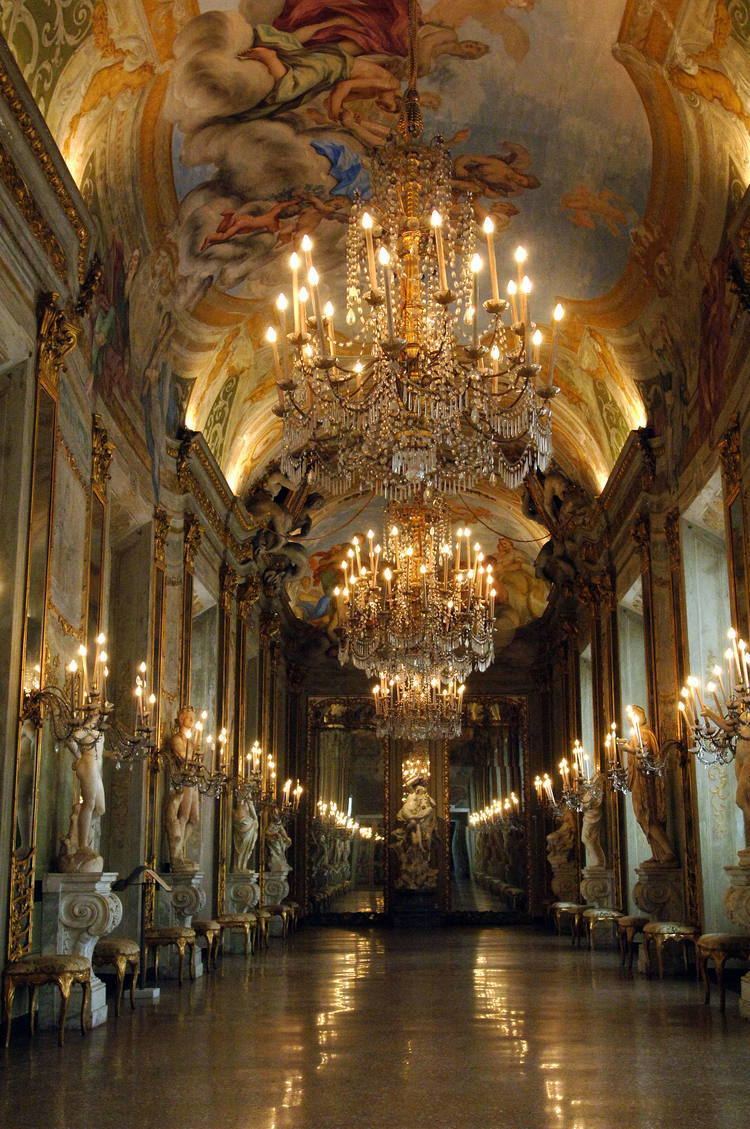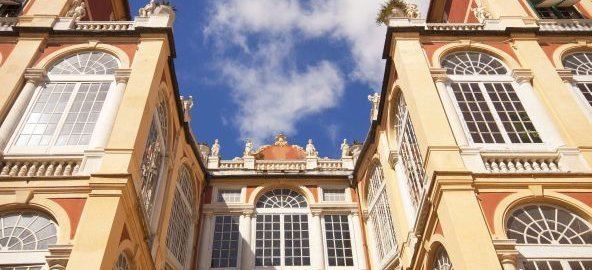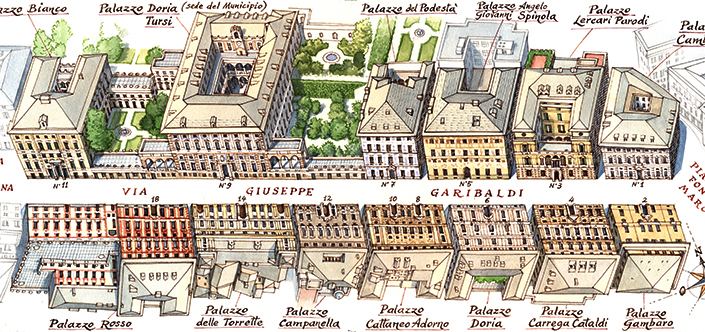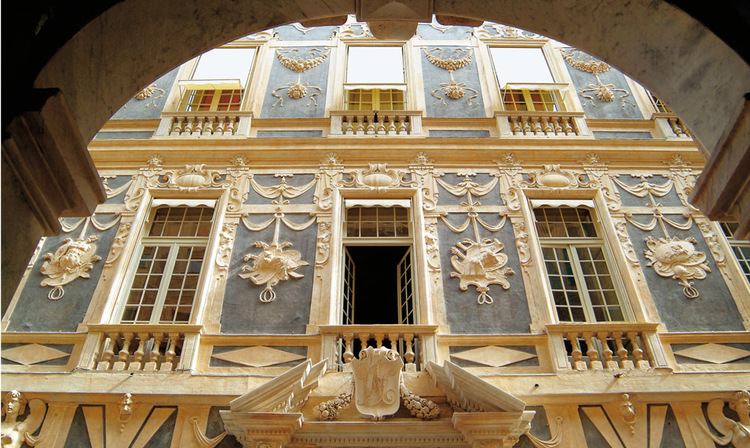 | ||
Similar Via Garibaldi, Palazzo Rosso, Palazzo Reale, Palazzo Bianco, Rolli de Génova | ||
Genoa le strade nuove and the system of the palazzi dei rolli unesco world heritage site
The Palazzi dei Rolli is a group of palaces in Genoa, northern Italy.
Contents
- Genoa le strade nuove and the system of the palazzi dei rolli unesco world heritage site
- I palazzi dei rolli di genova patrimonio unesco
- Rolli di Genova
- History
- The Palaces
- Rolli Days
- Palazzo Grillo seat of the De Andr Foundation
- References
On July 13, 2006, forty-two of eighty subscribers to 'Palazzi dei Rolli' or rolls' palaces were entered by the special committee UNESCO meeting in Vilnius (Lithuania) between the members. About 10 million euro was spent on their restoration in the 1990s with the use of public and private capital.

On January 20, 2007, a plaque was placed by UNESCO at the beginning of Via Garibaldi on the grounds that it inserts the description of Palazzi dei Rolli within the world heritage listing:

The largest homes, various in shape and distribution, that were chosen at random in the lists (rolli) to host visits of state. The buildings, often built on sloping land, formed of a stepped atrium - courtyard - staircase - garden and rich interior decorations, express a singular social and economic identity and commencement of modern age urban architecture in Europe.

I palazzi dei rolli di genova patrimonio unesco
Rolli di Genova

The Rolli di Genova - or, more precisely, Rolli degli alloggiamenti pubblici di Genova - formed an official list at the time of the Republic of Genoa, of public lodging palaces and mansions of eminent Genoese families, which aspired to host - from a public lottery - the persons in transit for visits of state.

In later times the same homes have hosted the distinguished visitors which included the Ligurian capital in their Grand Tour cultural and / or tourist itinerary.

The Rolli represent a set or un unicum of the most prestigious palaces of Genoa especially along the oldest roads of the Nuove Strade (Via Garibaldi with its commune, in those days termed Via Aurea, and via Balbi, home of the university town).
History

The rolli or rolls were created in 1576, open to the aristocratic Senate refounded by Prince (and Admiral) Andrea Doria, which through his constitutional reform introduced oligarchic rule and the subsequent insertion into the Genoese sovereignty of Spain.
The thoroughness with which Rolli were designed and completed only a few decades after the great urban restructuring decided by Doria - concentrated particularly between 1536 and 1553 between the fourteenth century strong Genoese walls - is still clear and documented evidence of Genoa during its "Golden Century". What was a city of shipowners, merchants and bankers in a position to give the Republic a role in maritime absolute dominance over the political and commercial Mediterranean Sea, was also an important crossroads for princes and kings, diplomats and ecclesiastical authority.

Still preserved in Genoa, the rolls of palaces were divided into compass points (Bussolotti) according to which the buildings were classified according to their prestige: the first was established in 1576, and later in 1588, 1599, 1614 and 1664. It is also cataloged all of the approximately one hundred and fifty homes that were mandatory (precettabili) for hosting notable people, in most cases these buildings still exist, as are the same people who led and still lead critics to look at Genoa at the time as a republican palace, a true contradiction in terms, from which emerge horizons of housing history and urban history, rather than one architecture.
The homes included in the Rolli are divided into three categories according to size, beauty and importance and were used according to these criteria to accommodate cardinals, princes and viceroys, feudal lords, ambassadors and governors. To each category of guest a Compass point (Bussolo) corresponded to the names of owners who competed by lot to support [charge] and honor (oneri ed onori) the official visits.
Only three of the buildings could accommodate the highest dignitaries and were the homes of Gio Batta Doria, on the climb to (Salita) Santa Caterina, of Nicolò Grimaldi and of Franco Lercari in the current Via Garibaldi, then called "Via Aurea". Provisions of the Rolli stated that these homes were reserved for "Pope, Emperor, King and tied Cardinals or other Principi".
Stendhal writes almost three hundred years after, when the Rolli had fallen into disuse:
I have tried to go to visit three galleries of famous paintings in via Balbi. Because the owners have the nice habit of living in apartments where are paintings, to be looked upon several times, and often the impatience that is my haughty refusal of valets takes away joy from paintings. The rich Genoa almost always occupy the third floor to see the sea. The steps of the stairs are marble but when, after having risen 100 of those steps, a valet, after waiting a quarter of an hour is to say: "His Excellency is still in his room, come back tomorrow", is allowed to have a shot of humor, especially when you have to share the evening ... (Stendhal, Memoires d'un touriste, 1837)
If the famous writer does not hide his anger at the lack of hospitality on the part of certain patrician Genoese, is also to be noted that the awareness of having a wealth of art and architecture of absolute value was such as to induce the most powerful and influential inhabitants of Genoa at the time to organize a census of the housing, not just to define clearly the limits of each property, but also to better arrange for an appropriate use.
The Palaces
These are the following forty-two buildings of the Rolli included among shared human heritage according to UNESCO:
Rolli Days
After the 2006 Rolli recognition by UNESCO as part of the world heritage, Genova municipality started in 2009 Rolli Days, dedicated to the free visit of public and private buildings. A different itinerary is proposed each time, and art students, architects and professional guides help the visitors offering guided tours, almost all for free.
Rolli Days happens twice a year, during a weekend in May and one in September. Exceptionally, to celebrate 10 years from UNESCO's recognition, in 2016 there were three weekends dedicated to Rolli Days (April, May and October).
The number of buildings open for the visit has constantly increased in time, and lately even palaces not originally belonging to the Rolli system (Genoa University historical building, for instance), summer villas located in the outskirt of Genoa and churches have been included in the tour.
Palazzo Grillo seat of the De André Foundation
One of the Rolli palaces - Palazzo Grillo in Piazza delle Vigne - was intended by the property to host the Foundation named after Fabrizio De André, famous songwriter from Genoa. Given the time required for the restoration of the building, the inauguration of the facility is scheduled for 2019, the tenth anniversary of his death in 2009.
Inside the home, located in the centre of Genoa, will be a café and / or a restaurant, an auditorium, public rooms (classrooms and information) devoted to the study of the Genoese school of singer-songwriters, the top floor of the residence could be a meeting place between guests.
FAI is in the process of completing the rehabilitation and restoration of Villa Saluzzo Bombrini, in the Albaro quarter, known as Il Paradiso and inhabited in his youth by De André.
